Threadleaf Coreopsis, Coreopsis verticillata
In the dogdays of summer as muslin curls on its own heat
And crickets cry in the black walnut tree
The winds lift up my life
And set it some distance from where it was…
-Meena Alexander
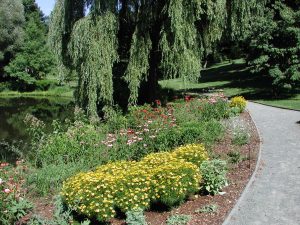 End of July, beginning of August qualify as the “dog days of summer” from the eras of the ancient Greeks and Romans (July 24 – August 24), down through time to readers of the Book of Common Prayers (July 6 – August 7), on to contemporary readers of the Old Farmer’s Almanac (July 3 – August 11). Often including the hottest stretch of summer weather, this phrase’s etymology began with an astronomical connection to the rising of Sirius, the brightest star in our night sky, part of the constellation Canis major, the Greater Dog.
End of July, beginning of August qualify as the “dog days of summer” from the eras of the ancient Greeks and Romans (July 24 – August 24), down through time to readers of the Book of Common Prayers (July 6 – August 7), on to contemporary readers of the Old Farmer’s Almanac (July 3 – August 11). Often including the hottest stretch of summer weather, this phrase’s etymology began with an astronomical connection to the rising of Sirius, the brightest star in our night sky, part of the constellation Canis major, the Greater Dog.
…Sirius rises late in the dark, liquid sky
On summer nights, star of stars,
Orion’s Dog they call it, brightest
Of all, but an evil portent, bringing heat
And fevers to suffering humanity…
-Homer, in the Iliad
Including some of the hottest summer temperatures, these days often may also be those with the least rainfall. Boston’s historic annual average precipitation total (snow/rain) is an enviable 43-inches. However, July is the driest month, with the lowest monthly average of 3.06-inches. Considering these seasonal heat and drought stresses, this month we profile a tough plant for tough places, albeit with exquisite flowering beauty.
 Threadleaf Coreopsis, Coreopsis verticillata is a perennial native from Maryland south to Georgia and westward to Arkansas and Oklahoma. The genus Coreopsis includes 75-80 different species native to North, Central and South America. Coreopsis is within the ASTERACEAE, the Aster family. Previously we have discussed Aster, Rudbeckia, Echinacea, Solidago and Eupatorium, from this huge botanical family, with differing taxonomists currently listing at least 1,300 genera and 23,000 species.
Threadleaf Coreopsis, Coreopsis verticillata is a perennial native from Maryland south to Georgia and westward to Arkansas and Oklahoma. The genus Coreopsis includes 75-80 different species native to North, Central and South America. Coreopsis is within the ASTERACEAE, the Aster family. Previously we have discussed Aster, Rudbeckia, Echinacea, Solidago and Eupatorium, from this huge botanical family, with differing taxonomists currently listing at least 1,300 genera and 23,000 species.
Threadleaf Coreopsis have bright golden yellow flowers, two-inches wide. As with many genera (but not all) in this family, their flowers are comprised of two flower-head strategies, disc flowers and ray flowers. The disc flowers in the center are multiple tiny florets containing reproductive structures (stamens and pistils). The colorful ray flowers (daisy-like) surrounding the center discs primarily serve to attract butterflies, bees and other pollinators which busy themselves with the disc flowers.
…painted all with variable flowers,
And all the meads adorned with dainty gems,
Fit to deck maiden’s bowers,
And crown their paramours…
-Edmund Spenser
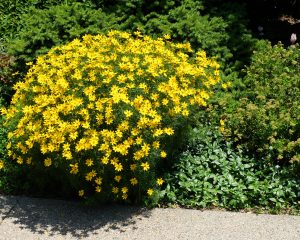 Many people upon first consideration might think wild occurring species are always best because of their natural origin. However, humans have selected and/or created cultivated varieties (same as cultivars), which have a desirable characteristic(s) that is maintained through propagation, often asexually. A readily recognizable example is the apple, one of the oldest cultivated fruits, there are at least 6,000 named cultivated varieties.
Many people upon first consideration might think wild occurring species are always best because of their natural origin. However, humans have selected and/or created cultivated varieties (same as cultivars), which have a desirable characteristic(s) that is maintained through propagation, often asexually. A readily recognizable example is the apple, one of the oldest cultivated fruits, there are at least 6,000 named cultivated varieties.
I love all sights of earth and skies,
From flowers that glow to stars that shine…
-Oliver Wendall Holmes
Coreopsis verticillata ‘Moonbeam’ is a superior compact cultivar, low mound of 1 to 1 ½ -foot- size, with flowers of a pale lemony-yellow which bloom from June until October. It has thread-like compound leaves creating an attractive delicate foliage mass when not in bloom and was named the Perennial Plant of the Year in 1992, by the Perennial Plant Association.
Coreopsis verticillata ‘Zagreb’ was the winner of the 2001 Royal Horticulture Society’s Award of Garden Merit. Also with thread-leaf foliage, this cultivar has brighter yellow flowers atop more erect stems, which make good cut flowers.
On your next visit to Mount Auburn look for these as well as other noticeable cultivars of Coreopsis growing at the Administration Building, Azalea Path, the Sphinx, Willow Pond Knoll and other locations.
…Till like the trembling golden stalk
Of some long-petaled star…
-Edith Sitwell




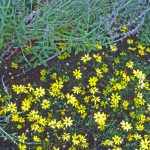

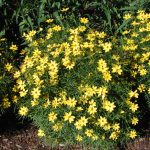

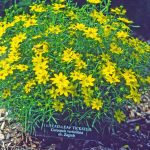
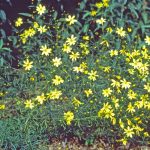
Leave a Reply